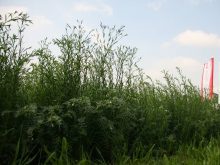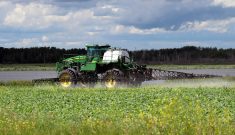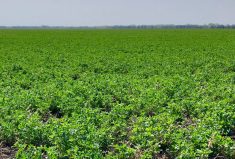It’s a major frustration for farmers and crop advisers when they discover disease in a field and realize it’s too late to do anything about it.
A new online tool developed by the Prairie Crop Disease Monitoring Network is designed to change that. The Quick Disease Reporter Tool allows users to electronically report disease outbreaks in common Canadian Prairie crops and give advance warning to farmers about emerging disease issues.
Kelly Turkington, a plant pathologist with Agriculture and Agri-Food Canada, is project coordinator for the app, which can be downloaded to most mobile phones and tablets. He says the tool was designed to alert farmers and consultants about emerging disease issues where closer field inspections and in-field risk assessment tools are needed to determine whether fungicide is warranted.
Read Also

Claas brings 1000 Series SP forage harvesters to Canada
In mid-August, Claas unveiled its new line of Jaguar forage harvesters at an event in Visalia, California, deep in the heart of that state’s dairy region.
“The tool and the maps that will be generated from it just give everyone a heads-up that there’s a problem starting to occur in (a) municipality. They can look at that information, say ‘I’m located there, I better go have a look at my crop,’” he says.
“As we start to see more and more reports in a municipality, that would serve as a trigger to alert people there is a disease issue in that region and that farmers need to be prompt and timely in terms of looking at that.”
App within an app
The tool is essentially an app within an app. Users must first download the Survey123 app from ArcGIS to their devices. Once that is installed, the network’s tool component must be added by scanning a QR code. Users then click on the “continue without signing in” option, which will take them to the disease reporter tool.
The user then taps the collect tab near the bottom of the screen to reach a place where they can file a report with the network. They will be asked to provide information on location (both province and RM or county), crop type and suspected disease.

They must also submit at least one photo of the field and the date the photo was taken. Users can provide their names and contact information if they want to consult with one of the network’s regional experts.
Once the report has been filed, it is verified by the network and information is added to an online map posted on the network’s website at prairiecropdisease.blogspot.com.
The organization also issues a report if there appears to be a developing disease issue in a specific region. That information is shared with provincial government agencies and multiple producer groups who distribute it to members. It’s also distributed on the network’s social media feed.
User friendly
Turkington says ensuring the app is user friendly was one of the top priorities during its design.
“Farmers are busy, crop consultants are busy. You want something that is easy to use and not some complicated thing that you get frustrated with,” he says.
Although the app was rolled out in 2021, initial uptake was slow among farmers and crop consultants. Turkington says severe drought in much of the Prairies that year was likely a factor because disease pressure wasn’t a high priority at the time.
“There wasn’t a whole lot of need for it and rightfully so. Producers’ minds were elsewhere,” he says.
Jeremy Boychyn, an agronomy research extension manager for the Alberta Wheat and Barley Commission, was an early adopter of the app. His job often entails working with researchers and industry experts to develop content for producers to use on their farms.
He spotted symptoms of what appeared to be bacterial leaf streak in a field and asked Turkington for his feedback. Turkington suggested he file a report using the app. Boychyn says he was impressed with how simple it was to install and use.
“It’s very simple and very straightforward once you’ve got it installed, especially for those who aren’t familiar with the installation of tools on their phone,” he says, adding it took him less than a minute to put the app on his phone.
“Once you get into submitting a report … it makes it very easy to report. You just fill in information about your general location, what you’re seeing, what crop you’re dealing with, your information and what you think you’re seeing. It’s really as easy as that.”
Connect with researchers
Boychyn says the app is a great tool for farmers and crop consultants because it allows them to easily connect with researchers who can confirm a crop disease.
“They then have a better idea of what they’re dealing with on their farms, and they can then make agronomic decisions to mitigate the impacts of the disease,” he says.
Boychyn also thinks the tool will be helpful in determining how future research dollars might be best spent.
“It can certainly help on a ground level, and in the long run it can help at an industry level to make sure we’re addressing the problems that are the most prevalent for farmers and agronomists as they’re seeing them in the field,” he adds.
Turkington says the network continues to tweak the app. It has already disabled the GPS tracking function in response to farmers’ security concerns.
In the latest iteration, designed in conjunction with Matthew McBurney of AAFC’s geomatics division, users simply enter the province and municipality.
Privacy detection
The network has added more crops and diseases to the app and is adding photos to aid in disease identification.
Turkington is hopeful more farmers and consultants will begin using the app as moisture levels and disease pressures return to more normal levels on the Prairies.
“The potential of this tool is really dependent on participation, whether it’s farmers themselves or consultants that advise them or researchers or extension staff,” he says. “The more participation that we have, the more useful that this tool will be for farmers and consultants.”
















